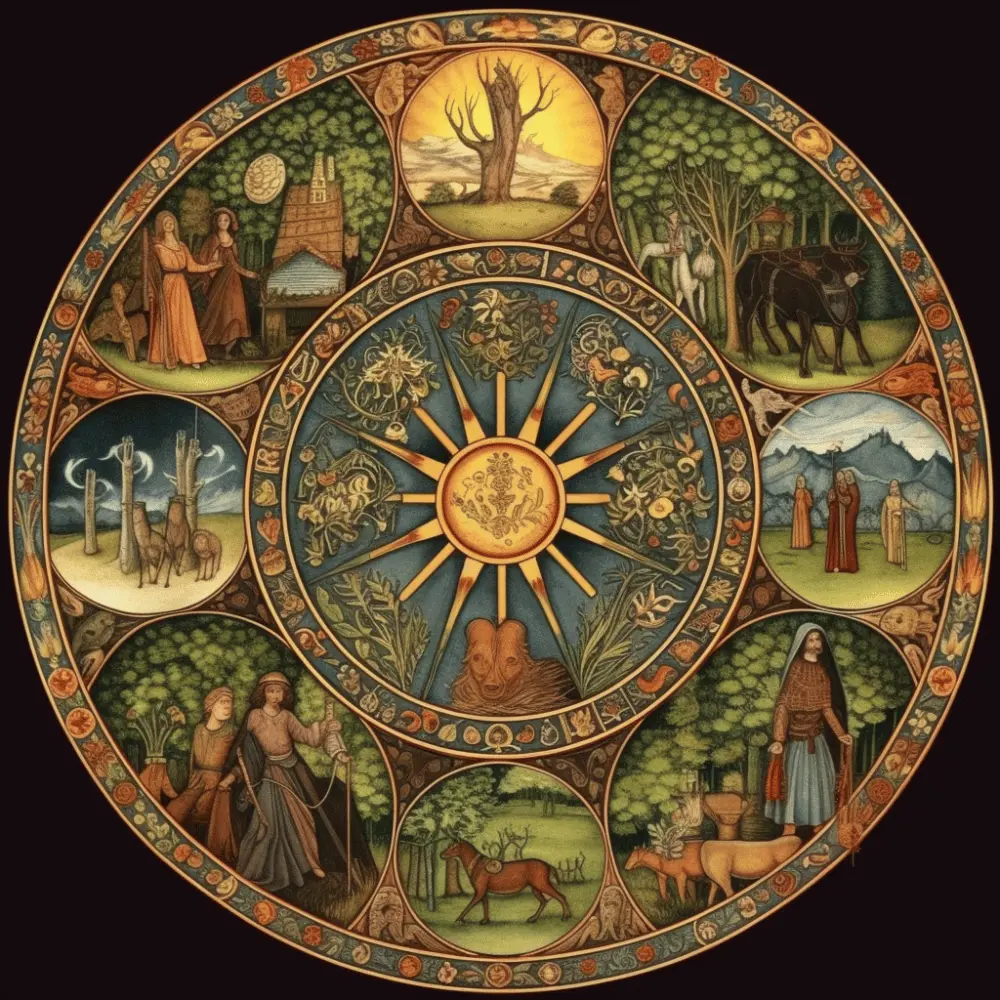The Wheel of the Year: A Journey Through Earth’s Seasonal Cycles
The Wheel of the Year is a fascinating representation of the annual cycle of seasonal festivals observed by many modern Pagans, Wiccans, and people interested in nature-based spirituality. With roots in ancient Celtic, Germanic, and Neopagan traditions, the Wheel of the Year consists of eight festivals, known as Sabbats. The eight festivals are divided into four major Sabbats and four minor Sabbats. The four major Sabbats are Samhain, Imbolc, Beltane, and Lughnasadh, which have Celtic origins. Each of the eight festivals occurs approximately six to seven weeks apart.
The four minor Sabbats are Yule, Ostara, Litha, and Mabon, which are derived from Germanic traditions. They all celebrate the ever-changing seasons. Understanding and celebrating these seasonal changes can help us connect with nature, deepen our understanding of the cycles of life, and find balance in our daily lives.
The Wheel of the Year Origins and Cultural Significance
The Wheel of the Year has roots in ancient Celtic and Germanic traditions, which were later adopted and adapted by modern Paganism and Wicca. These festivals celebrate the continuous cycle of birth, life, death, and rebirth, as well as the agricultural and pastoral cycles. The Wheel of the Year has had a significant influence on contemporary holidays and celebrations such as Halloween, Christmas, and Easter, connecting modern society with ancient wisdom.
The Eight Festivals
- Samhain (October 31st) marks the end of the harvest season and the beginning of the darker half of the year. Known as the “witches’ new year” due to its connection with the otherworldy and Celtic witches, Samhain is a time for honoring ancestors, divination, and introspection. Modern-day adaptations include Halloween and All Souls’ Day.
- Yule (around December 21st) celebrates the Winter Solstice, the shortest day of the year, and the return of the light. Traditions include decorating with evergreens, lighting candles, and gift-giving. Christmas has incorporated many Yule customs, such as the Christmas tree.
- Imbolc (February 1st or 2nd) honors the first signs of spring and the goddess Brigid, associated with healing, fertility, and inspiration. Celebrations often involve lighting candles and creating Brigid’s crosses. Groundhog Day and Candlemas have roots in Imbolc traditions.
- Ostara (around March 21st) celebrates the Spring Equinox and the balance between light and dark. It is a time of renewal, rebirth, and fertility. Customs include decorating eggs and celebrating the goddess of dawn, Eostre. Modern Easter celebrations have adopted many Ostara symbols.
- Beltane (May 1st) is a festival of fertility, fire, and the union of the god and goddess. Dancing around the Maypole and lighting bonfires are common customs. May Day celebrations continue these traditions today.
- Litha (around June 21st) marks the Summer Solstice, the longest day of the year, and is a time of celebration, abundance, and growth. Bonfires, feasting, and honoring the sun are common practices. Modern celebrations often include outdoor gatherings and picnics.
- Lughnasadh (August 1st) is the first of the three harvest festivals, honoring the Celtic god Lugh and marking the beginning of the harvest season. Traditions include baking bread, feasting, and participating in games and competitions. Lammas is a Christianized version of this festival.
- Mabon (around September 21st) is the Autumn Equinox and the second harvest festival, a time for gratitude, balance, and reflection. Celebrations often involve feasting on seasonal produce and giving thanks. Thanksgiving shares similarities with the themes of Mabon.

The Wheel of the Year and Personal Growth
Engaging with the Wheel of the Year offers opportunities for reflection, self-improvement, and connecting with nature. By attuning ourselves to the seasonal cycles, we can achieve balance and harmony in our daily lives.
Incorporating the Wheel of the Year into Modern Life
Adapting celebrations to fit personal beliefs and lifestyles: You don’t have to be a practicing Pagan or Wiccan to appreciate and participate in the Wheel of the Year festivals. People from diverse backgrounds can adapt and incorporate these celebrations into their own traditions and spiritual practices, honoring nature and the cycles of the Earth in ways that resonate with their own beliefs.
Fostering community and connection through shared traditions: Participating in the Wheel of the Year celebrations can help strengthen connections within families, friend groups, and communities. Sharing rituals, feasts, and customs related to these festivals can create a sense of unity and bonding, while also providing opportunities for learning and personal growth.
Preserving cultural heritage and ecological awareness: Embracing the Wheel of the Year can help preserve ancient cultural heritage and foster a greater appreciation for the environment. By celebrating the seasonal cycles, we can deepen our understanding of the interconnectedness of all living things and cultivate a sense of responsibility towards the Earth and its resources.
The Wheel of the Year offers a rich tapestry of seasonal festivals that celebrate the cycles of life and the natural world. Engaging with these celebrations can help us connect with nature, develop a deeper understanding of the rhythms of the Earth, and find balance and harmony in our daily lives. Whether you choose to participate in these festivals as part of your spiritual practice or simply as a way to honor the changing seasons, the Wheel of the Year invites us all to embrace the beauty and wisdom of the world around us.

